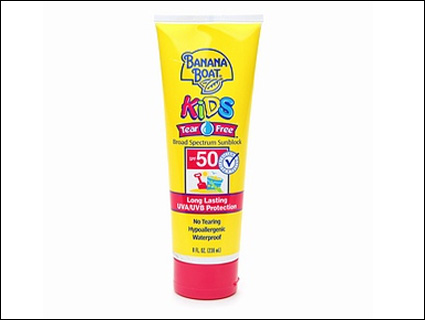
EarthlyDelights/<a href="http://www.flickr.com/photos/earthlydelights/4426492624/">Flickr</a>
As the Environmental Working Group found in its most recent sunscreen review, just because your Hawaiian Tropic sunscreen says it provides SPF 50 protection doesn’t mean it will. In fact, the real protection level is closer to SPF 10. And just because it’s “waterproof” doesn’t mean it will actually stay on in water. To curb false claims like these, the FDA has set some new rules for sunscreen manufacturers. The FDA has been promising to make guidelines for sunscreens since 1978: in fact, Mother Jones‘s 1993 May/June cover story mentioned that the FDA had “plans” to release new guidelines, and examined the confusing language and seals on sunscreen labels. At a minimum, the new FDA rules will require manufacturers to have more accurate labeling. More importantly, they’ll give consumers a better idea of what they’re getting.
The new rules, in a nutshell:
–all sunscreens must be SPF 15 or higher if they claim to prevent sunburn, early aging, and reduce skin cancer risk. Anything under SPF 15 could only be advertised to help prevent sunburn.
–all sunscreens must provide protection against both ultraviolet B radiation (UVB) and ultraviolet A radiation (UVA) in order to be labeled as “Broad Spectrum.”
–no more labels that market a sunscreen as either “waterproof” or “sweatproof.” The label “sunblock” is also disallowed.
–any product that claims water resistance must also tell consumers how much time they can expect to get SPF protection for while in the water.
–no product can claim to offer immediate protection after application unless they submit data to the FDA and get the FDA’s express approval
–sunscreens in the form of wipes, towelettes, powders, body washes, and shampoo cannot be marketed without approved application.
“This new information will help consumers know which products offer the best protection,” said FDA’s Lydia Velasquez. “We want consumers to understand that not all sunscreens are created equal.” The new rules will become effective in a year. In addition to them, the FDA has proposed regulation that would get rid of those ridiculous SPF 200 and SPF 150 numbers. Instead, the most a manufacturer would be able to advertise is “SPF 50+”. The FDA is also drafting guidelines to help sunscreen companies test and label their products to be in compliance with the regulations, and the agency is requesting information from manufacturers on just how effective their various sunscreen sprays, creams, oils, butters, sticks, gels, and lotions are.
While the new rules are a big step for the FDA, the Environmental Working Group (EWG) says it’s too little, too late. “It is clear that FDA caved to industry and weakened its safety standards,” said EWG’s David Andrews. “Its earlier [2007] draft proposed stronger health protections.” EWG says that even with the new regulations, 20% of sunscreens used in the US could not be sold in Europe because they do not provide enough UVA protection. The FDA, however, puts the responsibility on the consumer. “It is important for consumers to read the entire label, both front and back, in order to choose the appropriate sunscreen for their needs,” said FDA’s Velasquez.














